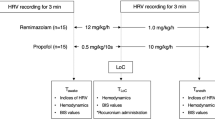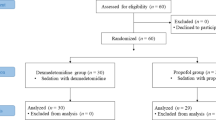Abstract
To evaluate the effects of subanesthetic enflurane and sevoflurane on the sympathetic nervous system (SNS) and the parasympathetic nervous system (PNS), the blood level of norepinephrine (NE) and fluctuations in the R-R intervals were measured on electrocardiogram in humans given either 0.5 MAC enflurane or sevoflurane. Enflurane suppressed circulating plasma NE and elevated coefficients of variation (CV) of R-R intervals after 20 and 30 min of inhalation. In contrast, 0.5 MAC of sevoflurane slightly stimulated cardiovascular function without any change in blood NE. Sevoflurane lowered the CV to 84% of control after 30 min of inhalation. These results indicate that subanesthetic concentrations of sevoflurane are unlikely to perturb sympathetic and parasympathetic activities in humans without surgical stimulation when compared with enflurane.
Similar content being viewed by others
References
Jenkins LC (1969) Pharmacological effects of anesthetics. In: General anesthesia and the central nervous system. Williams and Wilkins, Baltimore, pp 185–291
Marshal BE, Wollman H (1985) General anesthetics. In: Gilman AG, Goodman LS, et al. (eds) Pharmacological basis of therapeutics. Macmillan, New York pp 276–302
Price HL (1957) Circulatory adrenaline and noradrenaline during diethyl ether anesthesia in man. Clin Sci 16:377–378
Price HL, Linde HW, Jones RE, et al. (1959) Sympathoadrenal response to general anesthesia in man and their relation to hemodynamics. Anesthesiology 20:563–564
Ebert TJ, Kampine JP (1989) Nitrous oxide auguments sympathetic outflow: Direct evidence from human peroneal nerve recordings. Anesth Analg 69:444–449
Murakawa T, Satoh Y, Kudo T, et al. (1989) Effects of sevoflurane anesthesia and surgery on plasma catecholamine levels in Japanese, with English abstract. Masui (JPM J Anesthesiol) 38:1456–1462
Kubicek WG, Patterson RP, Witsoe DA (1970) Impedance cardiography as a noninvasive method of monitoring cardiac function and other parameters of the cardiovascular system. Ann NY Acad Sci 170:724
Person A, Solders G (1983) R-R variations, a test of autonomic dysfunction. Acta Neurol Scand 67:285–293
Ewing DJ, Neilson JMM, Travis P (1984) Irregularity of R-R interval cycle length during 24 hour ECG tape recording. Scot Med J 29:30–31
Guedel, AE (1937) Inhalation anesthesia, a fundamental guide. Macmilan, New York
Joyce JT, Roizen MF (1981) Application of face mask does not increase plasma norepinephrine levels. Anesth Analg 60:257–258
Skovsted P, Price HL (1972) The effects of ethrane on arterial pressure, preganglionic sympathetic activity and barostatic reflexes. Anesthesiology 36:257–262
Göthert M, Wendt J (1977) Inhibition of adrenal medullary catecholamine secretion by enflurane. I: Investigation in vivo. Anesthesiology 46:400–403
Miller RA, Warden JC, Cooperman LH, et al. (1969) Central sympathetic discharge and mean arterial pressure during halothane anaesthesia. Br J Anaesth 41:918–928
Miller RA, Warden JC, Cooperman LH, et al. (1970) Further studies of sympathetic actions of anaesthetics in intact and spinal animals. Br J Anaesth 42:366–378
Kawate R (1988) Influence to adrenal gland on inhalational anesthetic agent and sympathetic nerve system. Jiritu-Shinkei 25:76–89
Roizen MF, Horrigan RW, Frazer B (1981) Anesthetic dose blocking adrenergic (stress) and cardiovascular responses to incision. Anesthesiology 54:390–398
Brown FFIII, Owens WD, Felts JA, et al. (1982) Plasma epinephrine and norepinephrine levels during anesthesia: Enflurane-N2O−O2 compared with fentanyl-N2O−O2. Anesth Analg 61:366–370
Tsubo T, Iida T, Kudo T, et al. (1987) Effect of isoflurane anesthesia on glucose metabolism (in Japanese, with English abstract). Masui (JPM J Anesthesiol) 36:732–736
Smith TN, Eger IE, Stoelting KK, et al. (1970) The cardiovascular and sympathomimetic response to the addition of nitrous oxide to halothane in man. Anesthesiology 32:410–421
Sellgren J, Penten J, Wallin BG (1990) Percutaneous recording of muscle nerve sympathetic activity during propofol, nitrous oxide, and isoflurane anesthesia in humans. Anesthesiology 73:20–27
Wheeler T, Watkins PJ (1973) Cardiac denervation in diabetes. Br Med J 4:564–586
Sayers B McA (1973) Analysis of heart rate variability. Ergonomics 16:17–32
Author information
Authors and Affiliations
About this article
Cite this article
Kuramochi, K. Subanesthetic sevoflurane does not affect sympathetic or parasympathetic function. J Anesth 8, 12–16 (1994). https://doi.org/10.1007/BF02482745
Received:
Accepted:
Issue Date:
DOI: https://doi.org/10.1007/BF02482745




